Design Thinking Tools for Ideation
The ideation stage is a key point in the design thinking process (Known as Define in the Double Diamond Process). It is where the problem or the challenge is defined. The prototyped solutions may not achieve their target goals without a clear definition. Therefore, several design thinking tools can be applied to analyse the research data collected from the previous stage using different field research methods.
The Ideation allows the design team to translate the knowledge acquired during the inspiration, the first stage in the design thinking process, into a tangible model or a prototype. This clear definition of the problem puts the team at the heart of the design process as they can see, touch, evaluate, and brainstorm different challenges related to the newly produced ideas.
The Ideation lies in the middle of the design thinking process as it links between the inspiration research phase (How to Successfully Apply the Inspiration in Design Thinking), which helps us to research the problem at hand, and the implementation stage that turns the prototypes into a product or service. In this middle stage, the design team is allowed to visualise, brainstorm and evaluate ideas to reach a viable choice.
The design thinking tools and methods in this phase vary based on the type of the expected outcome, which can be either a product or service. Also, they vary based on the design process needs between brainstorming and evaluation tools.
Related articles:
- How to Successfully Apply the Inspiration in Design Thinking
- Design Thinking Guide: What, Why and How
- How Design Thinking Reshaped Microsoft Products
Brainstorming Design Thinking Tools
The brainstorming design thinking tools are when the team discusses different ideas and connect them to build a clear understanding of the connected elements in the situation. A clear definition of the situation contributes to building several prototype solutions. It is crucial to understand that there should be no negative comments or judgment on presented ideas during the brainstorming sessions. The facilitator must keep the session neutral to avoid biases. In How to Run a Successful Brainstorming Session, you will find a practice example of using the brainstorming as a design thinking method to explore ideas.
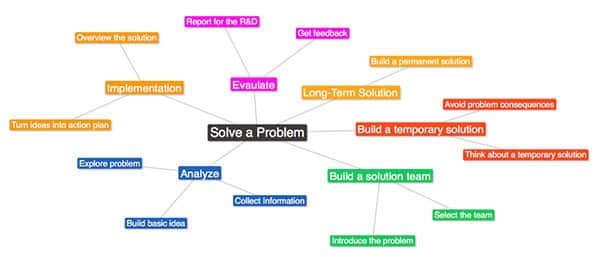
During brainstorming, the facilitator hands the attendees a pen and Post-its to write their ideas, and then they are added to a whiteboard. Each of the attendees starts to discuss their ideas with the group. As a result of these discussions, more ideas are discovered, which can also be added to the wall. The below TEDx Talk discusses creative think methods:
Reversed Brainstorming
When solving complex problems, the group may find defining or addressing ideas challenging. It is the point where there are no creative ideas, or the generated ideas are not efficient enough. One of the useful methods to overcome this situation is reversed brainstorming. In this tool, the group members reverse their mindset. They tend to create the problem or make existing issues more complex (Check Design Thinking Tools: Reverse Brainstorming).
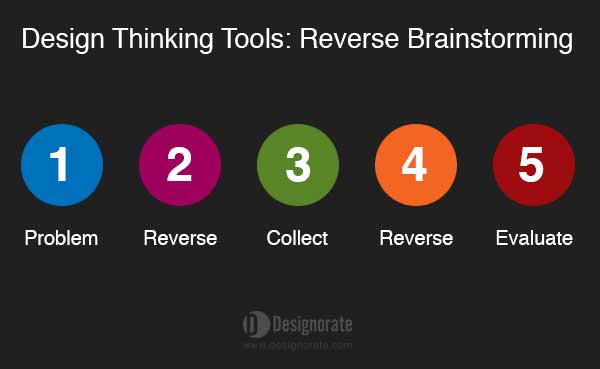
In the reversed brainstorming, the group members move between five main stages as follows:
Problem – In this stage, the team defines the problem that must be solved through the final product or service.
Reverse – The team reverses their mindset by thinking about how to make the problem worse.
Collect – The team starts brainstorming ideas that can make the problem worse and discuss with this approach in mind.
Reverse – The ideas are reversed to form solutions or suggest solutions for the problem.
Evaluate – The team evaluates the different solutions and sees if it works as a solution for the original problem. Note that the main idea of this stage is to check if the statements provide solutions for the issue after reversing it.
Lotus Blossom Diagram
The Lotus Blossom Diagram is a mind-mapping tool that allows you to organize ideas and visualize them in sub-categories of each idea. It presents a more organized form of mind maps (Check Common Types of Mind Maps and How to Use Them).
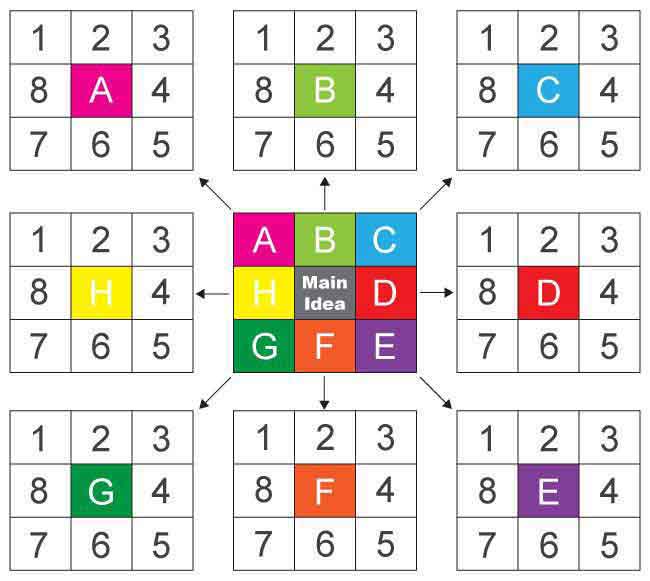
The Lotus Blossom Diagram final result should look like the above figure after following the below steps:
1- Write the main problem in the centre of the diagram
2- Write eight themes related to the situation in the squares around the central problem
3- Separate each of the main themes in a new subset and use it as the core for a new set of ideas
4- Continue the process until all the ideas are visualized and linked together
Design Thinking Tools for Evaluation
Sometimes, we need to evaluate situations using business tools or investigate the problem’s root cause based on the collected data. After brainstorming ideas, it is time to assess them and isolate the most efficient solutions to take to the next prototyping stage. While the brainstorming stage avoids judgment on the suggested ideas, the evaluation aims to evaluate and critique them.
SWOT Analysis
The SWOT Analysis is a method that allows you to evaluate ideas from four main perspectives; strength (S), weakness (W), opportunities (O) and threats (T). In this method, ideas are evaluated using the above four factors in order to understand their market viability (Check SWOT Analysis: Exploring Innovation and Creativity within Organizations).
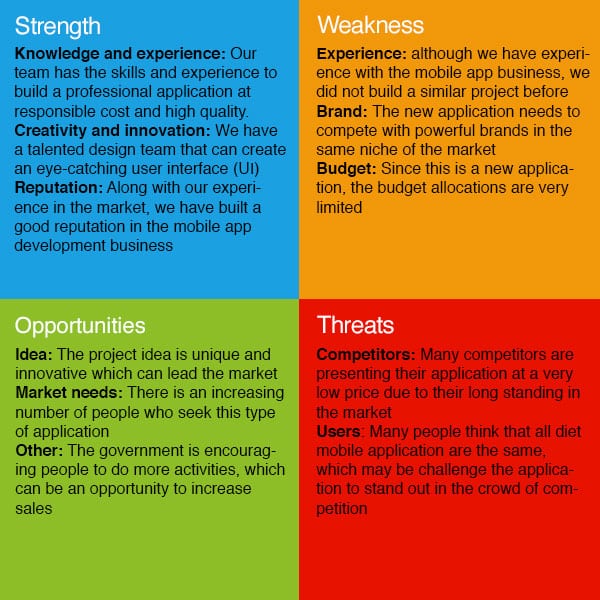
In this stage, the team investigates each idea based on those four dimensions, such as the following:
Strengths – What are the advantages of the new product or service?
Weakness – What are the factors that reduce your sales?
Opportunities – What are the opportunities for the new product?
Threats – Who are the existing or potential competitors?
SCAMPER
The SCAMPER method examines the methods that may strengthen ideas based on seven factors; Substitute, Combine, Adapt, Modify, Put to other uses, Eliminate, and Rearrange. Unlike the SWOT analysis, the SCAMPER technique evaluates how an idea can be pushed further using the above factors. It provides a valuable tool for evaluating ideas and making them solid enough for the next stage (Check A Guide to the SCAMPER Technique for Creative Thinking).
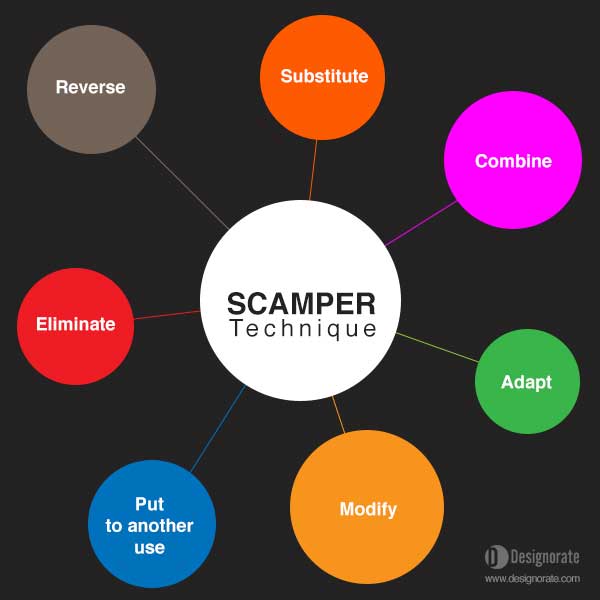
The team members evaluate each idea and brainstorm the potentials to make make it more successful in the market using each of the seven factors as following:
Substitute – The substitute technique focuses on the parts in the product, service or solution that can be replaced with another.
Combine – The combine technique tends to analyze the possibility of merging two ideas, stages of the process or product in one single more efficient output.
Adapt – Adapt refers to a brainstorming discussion that aims to adjust or tweak product or service for a better output.
Modify, minify or magnify – The modify technique refers to changing the process in a way that unleashes more innovative capabilities or solves problems.
Put to another use – This technique concerns how to put the current product or process for another purpose or how to use the existing product to solve problems.
Consumer Journey Maps
The journey maps aim to visualize the consumer experience while using the product or service, such as visiting a shopping mall. In addition to the user experience, the journey map lets you identify the emotional experience through empathy persona maps (Check 7 Steps to Create a Successful Journey Map).
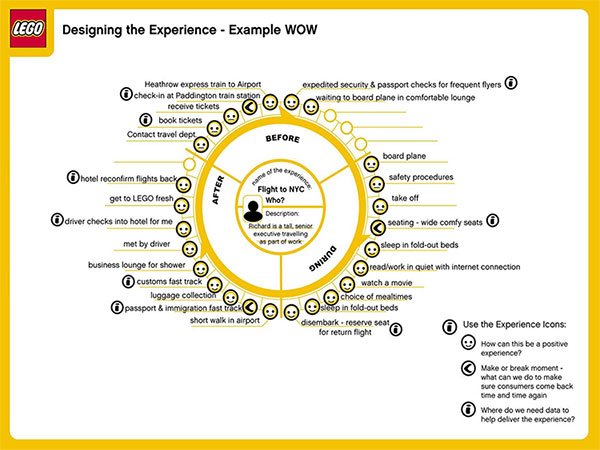
In this method, the team defines the service’s main objective and follows the user experience through his journey. Then the team documents the touch points with the service, such as product shelves and checkout points, to learn the consumers’ problems and solve them through iterative the designed model.
Task Analysis Grids
The Task Analysis Grid is a document that aims to divide the service into small parts that the stakeholders can track to know the consumer experience, the involvement of the team, and the suggestions to solve it as follows: (Check How to Use Task Analysis Grid in Service Design).
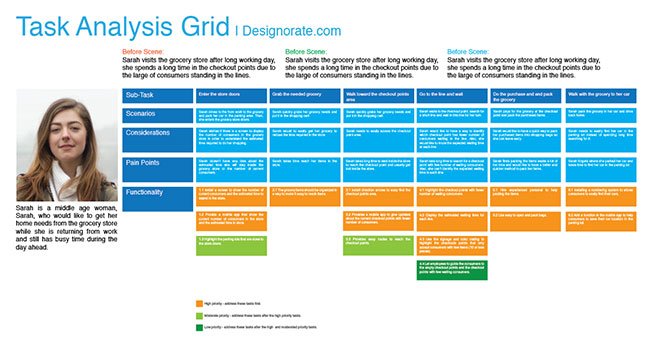
1- Define the persona and problem
2- Define the sub-tasks
3- Put the action scenarios for each sub-task
4- Considerations to improve the experience
5- Define the consumer pain points
6- Translate solutions for the pain points into the functionality
Further reading:
Design Thinking Process & Methods 5th Edition
This stage prepares for the prototyping stage, where the select ideas are visualised to get feedback from the client stockholders, including the clients working on the project. The type of the prototype depends on the nature of the project. For example, rapid prototyping is suitable for both digital and physical products. It aims to build a workable visual demo for the product to allow the team and client sample to test, evaluate, and provide feedback. This feedback is then used in the iterative process to improve the product before mass production.
The rapid prototypes vary in both physical and digital products. The physical effects, the prototype can be created using clay, paper, mixed materials, and 3D printing (additive manufacturing). In digital products such as mobile applications, websites, and game design, the prototype takes the form of a pilot, demo, or Alpha version. These prototypes are an incomplete version of the digital product with all the features and layout represented to allow the client to test and give feedback.
The ideation phase presents a middle point between the inspiration and implementation stages in the design thinking process. Thus, it plays a significant role in visualising the research results and team ideas to help the stakeholders and the consumer sample to test, give feedback, and iterative the product or the service to improve it. However, the success of this stage can’t be achieved without a deep understanding of the proper tools to use through this stage. For example, the brainstorming tools help us to create a pool of ideas to evaluate later using the evaluation tools. Once the top ideas are selected, they can be transformed into prototypes to test and provide feedback. The accurate feedback process presents one of the most important factors contributing to a successful product or service.
Summary:
Brainstorming
Reversed brainstorming
Lotus Blossom Diagram
SCAMPER
Consumer Journey Maps
Task Analysis Grids







Fantastic Jives very well with what Technology Education teachers have been promoting. This helps them tremendously.
Very detailed and clear article. I really like the Lotus Blossom approach as a simple advance on mind mapping. An idea I will blatantly steal. 😉
Dear Colin, I just saw your comment now! I was not working much in the website. But I’m really glade you liked it and thanks for your words!